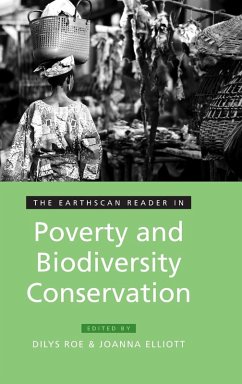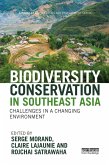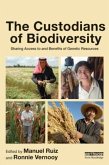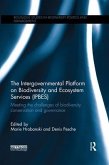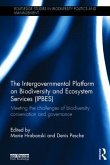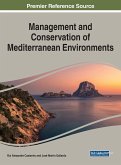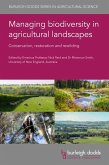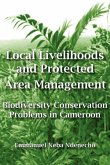The Earthscan Reader in Poverty and Biodiversity Conservation
Herausgeber: Roe, Dilys; Elliott, Joanna
The Earthscan Reader in Poverty and Biodiversity Conservation
Herausgeber: Roe, Dilys; Elliott, Joanna
- Gebundenes Buch
- Merkliste
- Auf die Merkliste
- Bewerten Bewerten
- Teilen
- Produkt teilen
- Produkterinnerung
- Produkterinnerung
The role and value of biodiversity conservation in supporting the livelihoods of poor people has been widely debated during the last two or three decades. Within the last few years, however, the debate on the link between nature conservation and poverty reduction appears to have become more vociferous, and, at times, acrimonious. The contemporary debate on conservation and poverty appears to revolve around four key themes:
Andere Kunden interessierten sich auch für
![Biodiversity Conservation in Southeast Asia Biodiversity Conservation in Southeast Asia]() Biodiversity Conservation in Southeast Asia67,99 €
Biodiversity Conservation in Southeast Asia67,99 €![The Custodians of Biodiversity The Custodians of Biodiversity]() The Custodians of Biodiversity58,99 €
The Custodians of Biodiversity58,99 €![The Intergovernmental Platform on Biodiversity and Ecosystem Services (IPBES) The Intergovernmental Platform on Biodiversity and Ecosystem Services (IPBES)]() The Intergovernmental Platform on Biodiversity and Ecosystem Services (IPBES)72,99 €
The Intergovernmental Platform on Biodiversity and Ecosystem Services (IPBES)72,99 €![The Intergovernmental Platform on Biodiversity and Ecosystem Services (IPBES) The Intergovernmental Platform on Biodiversity and Ecosystem Services (IPBES)]() The Intergovernmental Platform on Biodiversity and Ecosystem Services (IPBES)218,99 €
The Intergovernmental Platform on Biodiversity and Ecosystem Services (IPBES)218,99 €![Management and Conservation of Mediterranean Environments Management and Conservation of Mediterranean Environments]() Management and Conservation of Mediterranean Environments261,99 €
Management and Conservation of Mediterranean Environments261,99 €![Managing biodiversity in agricultural landscapes Managing biodiversity in agricultural landscapes]() Emeritus Ni ReidManaging biodiversity in agricultural landscapes266,99 €
Emeritus Ni ReidManaging biodiversity in agricultural landscapes266,99 €![Local Livelihoods and Protected Area Management. Biodiversity Conservation Problems in Cameroon Local Livelihoods and Protected Area Management. Biodiversity Conservation Problems in Cameroon]() Emmanuel Neba NdenechoLocal Livelihoods and Protected Area Management. Biodiversity Conservation Problems in Cameroon61,99 €
Emmanuel Neba NdenechoLocal Livelihoods and Protected Area Management. Biodiversity Conservation Problems in Cameroon61,99 €-
The role and value of biodiversity conservation in supporting the livelihoods of poor people has been widely debated during the last two or three decades. Within the last few years, however, the debate on the link between nature conservation and poverty reduction appears to have become more vociferous, and, at times, acrimonious. The contemporary debate on conservation and poverty appears to revolve around four key themes:
Hinweis: Dieser Artikel kann nur an eine deutsche Lieferadresse ausgeliefert werden.
Hinweis: Dieser Artikel kann nur an eine deutsche Lieferadresse ausgeliefert werden.
Produktdetails
- Produktdetails
- Verlag: Routledge
- Seitenzahl: 418
- Erscheinungstermin: 26. Februar 2010
- Englisch
- Abmessung: 240mm x 161mm x 27mm
- Gewicht: 790g
- ISBN-13: 9781844078424
- ISBN-10: 1844078426
- Artikelnr.: 26875190
- Herstellerkennzeichnung
- Libri GmbH
- Europaallee 1
- 36244 Bad Hersfeld
- gpsr@libri.de
- Verlag: Routledge
- Seitenzahl: 418
- Erscheinungstermin: 26. Februar 2010
- Englisch
- Abmessung: 240mm x 161mm x 27mm
- Gewicht: 790g
- ISBN-13: 9781844078424
- ISBN-10: 1844078426
- Artikelnr.: 26875190
- Herstellerkennzeichnung
- Libri GmbH
- Europaallee 1
- 36244 Bad Hersfeld
- gpsr@libri.de
Dilys Roe is a Senior Researcher in the Natural Resources Group at the International Institute for Environment and Development (IIED), London, UK. Joanna Elliott is Vice President for Program Design and Knowledge Management at the African Wildlife Foundation.
1. Biodiversity Conservation and Poverty Reduction:
An Introduction to the Debate
Part I: Linking Biodiversity Conservation and Poverty Reduction - Where,
How and Why?
Editors' Introduction
2. Biodiversity Conservation and the Eradication of Poverty
3.Linking Conservation and Poverty Reduction: Landscapes, People and Power
4. Poverty, Development and Biodiversity Conservation: Shooting in the
Dark?
5. Livelihoods, Forests and Conservation in Developing Countries: An
Overview
Part II: Conservation's Place in International Development
Editors' Introduction
6. Integrating the Rio Conventions into Development Co-operation
7. Wildlife and Poverty Study
8. Striking a Balance: Ensuring Conservation's Place on the International
Biodiversity Assistance Agenda
9. Report of the Ad Hoc Open-ended Working Group of Review of
Implementation of the Convention
10. Contested Relationships between Biodiversity Conservation and Poverty
Alleviation
11. Poverty and Conservation: The New Century's 'Peasant Question?'
12. Making Poverty Reduction Irreversible: Development Implications of the
Millennium Ecosystem Assessment
Part III: Conservation Policy and Protectionism
Editors' Introduction
13. Protected Areas and Poverty - The Linkages and How to Address Them
14. Conservation Policy and Indigenous Peoples
15. The Role of Protected Areas in Conserving Biodiversity and Sustaining
Local Livelihoods.
16. Eviction for Conservation: A Global Overview
17. Political Ecology and the Costs and Benefits of Protected Areas
18. A Property Rights Approach to Understanding Human Displacement from
Protected Areas: The Case of Marine Protected Areas
Part IV: Conservation NGOs and Poor People
Editors' Introduction
19. Two Agendas on Amazon Development
20. International Conservation Organisations and the Fate of Local Tropical
Forest Conservation Initiatives
21. A Challenge to Conservationists
22. Conservation, Development and Poverty Alleviation: Time for a Change in
Attitudes
23. Conserving What and for Whom? Why Conservation Should Help Meet Basic
Needs in the Tropics
24. Disentangling the Links between Conservation and Poverty Reduction in
Practice
Part V: New Developments: Ecosystem Services, Carbon and Climate Change
Editors' Introduction
25. Ecosystems and Human Well-being: Current State and Trends
26. Selling Out on Nature (and letters in response)
27. Payments for Environmental Services and the Poor: Concepts and
Preliminary Evidence
28. Climate, Carbon, Conservation and Communities
29. Protecting the Future: Carbon, Forests, Protected Areas and Local
Livelihoods
30. Seeing REDD? Forests, Climate Change Mitigation the Rights of
Indigenous Peoples and Local Communities
Part VI: Moving Beyond the Debate - The Need for Conservation-poverty
Partnerships
Editors' Introduction
31. Partnerships for Conservation and Poverty Reduction
32. Common Ground between Anthropology and Conservation Biology
33. Thinking Like a Human: Social Science and the Two Cultures Problem
An Introduction to the Debate
Part I: Linking Biodiversity Conservation and Poverty Reduction - Where,
How and Why?
Editors' Introduction
2. Biodiversity Conservation and the Eradication of Poverty
3.Linking Conservation and Poverty Reduction: Landscapes, People and Power
4. Poverty, Development and Biodiversity Conservation: Shooting in the
Dark?
5. Livelihoods, Forests and Conservation in Developing Countries: An
Overview
Part II: Conservation's Place in International Development
Editors' Introduction
6. Integrating the Rio Conventions into Development Co-operation
7. Wildlife and Poverty Study
8. Striking a Balance: Ensuring Conservation's Place on the International
Biodiversity Assistance Agenda
9. Report of the Ad Hoc Open-ended Working Group of Review of
Implementation of the Convention
10. Contested Relationships between Biodiversity Conservation and Poverty
Alleviation
11. Poverty and Conservation: The New Century's 'Peasant Question?'
12. Making Poverty Reduction Irreversible: Development Implications of the
Millennium Ecosystem Assessment
Part III: Conservation Policy and Protectionism
Editors' Introduction
13. Protected Areas and Poverty - The Linkages and How to Address Them
14. Conservation Policy and Indigenous Peoples
15. The Role of Protected Areas in Conserving Biodiversity and Sustaining
Local Livelihoods.
16. Eviction for Conservation: A Global Overview
17. Political Ecology and the Costs and Benefits of Protected Areas
18. A Property Rights Approach to Understanding Human Displacement from
Protected Areas: The Case of Marine Protected Areas
Part IV: Conservation NGOs and Poor People
Editors' Introduction
19. Two Agendas on Amazon Development
20. International Conservation Organisations and the Fate of Local Tropical
Forest Conservation Initiatives
21. A Challenge to Conservationists
22. Conservation, Development and Poverty Alleviation: Time for a Change in
Attitudes
23. Conserving What and for Whom? Why Conservation Should Help Meet Basic
Needs in the Tropics
24. Disentangling the Links between Conservation and Poverty Reduction in
Practice
Part V: New Developments: Ecosystem Services, Carbon and Climate Change
Editors' Introduction
25. Ecosystems and Human Well-being: Current State and Trends
26. Selling Out on Nature (and letters in response)
27. Payments for Environmental Services and the Poor: Concepts and
Preliminary Evidence
28. Climate, Carbon, Conservation and Communities
29. Protecting the Future: Carbon, Forests, Protected Areas and Local
Livelihoods
30. Seeing REDD? Forests, Climate Change Mitigation the Rights of
Indigenous Peoples and Local Communities
Part VI: Moving Beyond the Debate - The Need for Conservation-poverty
Partnerships
Editors' Introduction
31. Partnerships for Conservation and Poverty Reduction
32. Common Ground between Anthropology and Conservation Biology
33. Thinking Like a Human: Social Science and the Two Cultures Problem
1. Biodiversity Conservation and Poverty Reduction:
An Introduction to the Debate
Part I: Linking Biodiversity Conservation and Poverty Reduction - Where,
How and Why?
Editors' Introduction
2. Biodiversity Conservation and the Eradication of Poverty
3.Linking Conservation and Poverty Reduction: Landscapes, People and Power
4. Poverty, Development and Biodiversity Conservation: Shooting in the
Dark?
5. Livelihoods, Forests and Conservation in Developing Countries: An
Overview
Part II: Conservation's Place in International Development
Editors' Introduction
6. Integrating the Rio Conventions into Development Co-operation
7. Wildlife and Poverty Study
8. Striking a Balance: Ensuring Conservation's Place on the International
Biodiversity Assistance Agenda
9. Report of the Ad Hoc Open-ended Working Group of Review of
Implementation of the Convention
10. Contested Relationships between Biodiversity Conservation and Poverty
Alleviation
11. Poverty and Conservation: The New Century's 'Peasant Question?'
12. Making Poverty Reduction Irreversible: Development Implications of the
Millennium Ecosystem Assessment
Part III: Conservation Policy and Protectionism
Editors' Introduction
13. Protected Areas and Poverty - The Linkages and How to Address Them
14. Conservation Policy and Indigenous Peoples
15. The Role of Protected Areas in Conserving Biodiversity and Sustaining
Local Livelihoods.
16. Eviction for Conservation: A Global Overview
17. Political Ecology and the Costs and Benefits of Protected Areas
18. A Property Rights Approach to Understanding Human Displacement from
Protected Areas: The Case of Marine Protected Areas
Part IV: Conservation NGOs and Poor People
Editors' Introduction
19. Two Agendas on Amazon Development
20. International Conservation Organisations and the Fate of Local Tropical
Forest Conservation Initiatives
21. A Challenge to Conservationists
22. Conservation, Development and Poverty Alleviation: Time for a Change in
Attitudes
23. Conserving What and for Whom? Why Conservation Should Help Meet Basic
Needs in the Tropics
24. Disentangling the Links between Conservation and Poverty Reduction in
Practice
Part V: New Developments: Ecosystem Services, Carbon and Climate Change
Editors' Introduction
25. Ecosystems and Human Well-being: Current State and Trends
26. Selling Out on Nature (and letters in response)
27. Payments for Environmental Services and the Poor: Concepts and
Preliminary Evidence
28. Climate, Carbon, Conservation and Communities
29. Protecting the Future: Carbon, Forests, Protected Areas and Local
Livelihoods
30. Seeing REDD? Forests, Climate Change Mitigation the Rights of
Indigenous Peoples and Local Communities
Part VI: Moving Beyond the Debate - The Need for Conservation-poverty
Partnerships
Editors' Introduction
31. Partnerships for Conservation and Poverty Reduction
32. Common Ground between Anthropology and Conservation Biology
33. Thinking Like a Human: Social Science and the Two Cultures Problem
An Introduction to the Debate
Part I: Linking Biodiversity Conservation and Poverty Reduction - Where,
How and Why?
Editors' Introduction
2. Biodiversity Conservation and the Eradication of Poverty
3.Linking Conservation and Poverty Reduction: Landscapes, People and Power
4. Poverty, Development and Biodiversity Conservation: Shooting in the
Dark?
5. Livelihoods, Forests and Conservation in Developing Countries: An
Overview
Part II: Conservation's Place in International Development
Editors' Introduction
6. Integrating the Rio Conventions into Development Co-operation
7. Wildlife and Poverty Study
8. Striking a Balance: Ensuring Conservation's Place on the International
Biodiversity Assistance Agenda
9. Report of the Ad Hoc Open-ended Working Group of Review of
Implementation of the Convention
10. Contested Relationships between Biodiversity Conservation and Poverty
Alleviation
11. Poverty and Conservation: The New Century's 'Peasant Question?'
12. Making Poverty Reduction Irreversible: Development Implications of the
Millennium Ecosystem Assessment
Part III: Conservation Policy and Protectionism
Editors' Introduction
13. Protected Areas and Poverty - The Linkages and How to Address Them
14. Conservation Policy and Indigenous Peoples
15. The Role of Protected Areas in Conserving Biodiversity and Sustaining
Local Livelihoods.
16. Eviction for Conservation: A Global Overview
17. Political Ecology and the Costs and Benefits of Protected Areas
18. A Property Rights Approach to Understanding Human Displacement from
Protected Areas: The Case of Marine Protected Areas
Part IV: Conservation NGOs and Poor People
Editors' Introduction
19. Two Agendas on Amazon Development
20. International Conservation Organisations and the Fate of Local Tropical
Forest Conservation Initiatives
21. A Challenge to Conservationists
22. Conservation, Development and Poverty Alleviation: Time for a Change in
Attitudes
23. Conserving What and for Whom? Why Conservation Should Help Meet Basic
Needs in the Tropics
24. Disentangling the Links between Conservation and Poverty Reduction in
Practice
Part V: New Developments: Ecosystem Services, Carbon and Climate Change
Editors' Introduction
25. Ecosystems and Human Well-being: Current State and Trends
26. Selling Out on Nature (and letters in response)
27. Payments for Environmental Services and the Poor: Concepts and
Preliminary Evidence
28. Climate, Carbon, Conservation and Communities
29. Protecting the Future: Carbon, Forests, Protected Areas and Local
Livelihoods
30. Seeing REDD? Forests, Climate Change Mitigation the Rights of
Indigenous Peoples and Local Communities
Part VI: Moving Beyond the Debate - The Need for Conservation-poverty
Partnerships
Editors' Introduction
31. Partnerships for Conservation and Poverty Reduction
32. Common Ground between Anthropology and Conservation Biology
33. Thinking Like a Human: Social Science and the Two Cultures Problem

